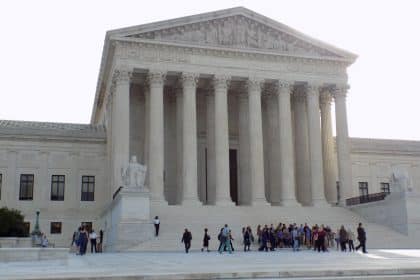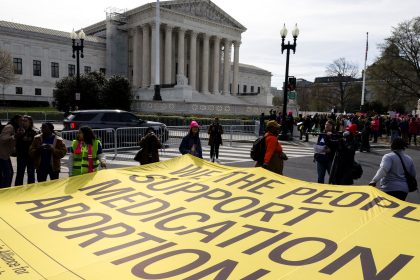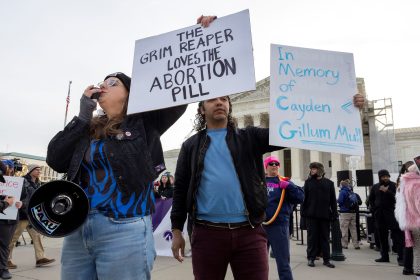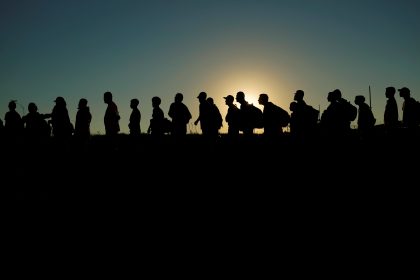Supreme Court Opens Term With New Justice, In-Person Oral Arguments
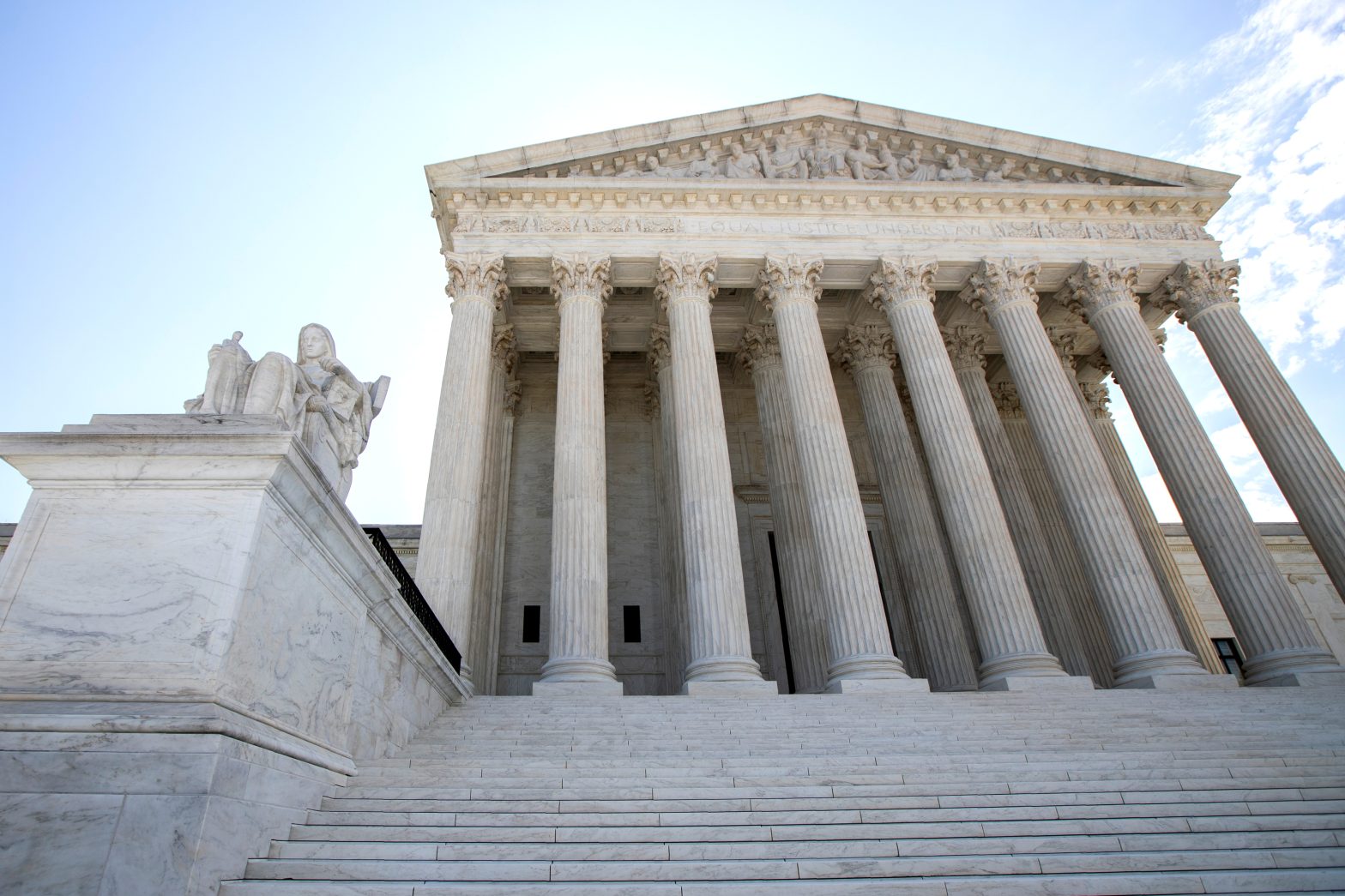
WASHINGTON — The Supreme Court opens its new term on Monday with a new justice — Ketanji Brown Jackson — among its members and, for the first time since the onset of the COVID-19 pandemic, hearing oral arguments live in the courtroom.
In a brief press release posted on the Supreme Court website late last week, the court announced that it is currently planning to hear all scheduled oral arguments for the upcoming term in the courtroom with seating provided to the public, members of the Supreme Court bar and the press.
In addition, the court will continue to provide a live audio feed of oral arguments, with a link to the feed being made available on the court’s website.
Also, the oral argument audio and a transcript of those arguments will be posted on the court’s website each afternoon.
Of note to attorneys, courtroom bar admissions will also resume this week. The Supreme Court building, however, will otherwise be closed to the public until further notice.
After a term marked by controversial decisions on abortion, gun rights and the power of regulatory agencies, the justices are preparing to wade into a host of weighty issues this term. These include voting rights, affirmative action and the rights of members of the LGBTQ+ community.
A number of cases involving the regulation of businesses, large and small, are also scheduled to be heard, and of course, the justices will likely add more cases to their docket as the 2022-2023 session proceeds.
Below are some of the cases the court has agreed to hear before the current term ends in late June 2023:
Clean Water Act
The justices return to the bench on Monday wading into a case, Sackett v. Environmental Protection Agency, with widespread implications for how the Environmental Protection Agency combats water pollution.
The long-running case involves an Idaho couple who won an earlier high court round in their bid to build a house on property near a lake without getting a permit under the Clean Water Act.
The outcome of the case could change the rules for millions of acres of property that contain wetlands.
Michael and Chantell Sackett purchased an undeveloped lot located about 300 feet from Priest Lake, near the U.S.-Canada border in the Idaho panhandle in 2004.
Three years later, in 2007, the couple obtained building permits from the county and began preliminary work on what they planned to be their new home.
As part of this work, about 1,700 cubic yards of gravel and sand was deposited on the lot, prompting a notice from the EPA that the project had to stop.
According to the EPA, the two-thirds of an acre lot contained wetlands protected by the Clean Water Act, which prohibits the discharge of pollutants — including gravel and sand — into “navigable waters.”
The EPA ordered the Sacketts to restore the site to its original condition or face fines that could amount to over $40,000 per day.
The Sacketts sued the agency in federal court, challenging its authority to regulate their land under the Clean Water Act.
In 2012, the case made it to the Supreme Court, which determined the Sacketts could indeed pursue their case in federal court.
U.S. District Judge Edward Lodge, presiding in Idaho, eventually ruled for the EPA, and the 9th U.S. Circuit Court of Appeals upheld that decision.
The Sacketts then appealed to the Supreme Court, asking it to revisit its 2006 decision in Rapanos v. United States, in which the court held the Clean Water Act does not regulate all wetlands but did not produce a majority for the governing standard.
In January 2022, the court agreed to take up the Sacketts’ case and decide whether the 9th Circuit used the proper test to decide whether wetlands are “waters of the United States” for purposes of the Clean Water Act.
The Sacketts are urging the justices to adopt a test, proposed by a four-justice plurality in Rapanos, that would only allow the EPA to regulate wetlands that have a continuous surface water connection to regulated waters.
They will also argue that if a majority of justices agree, then their lot would fail the test because a gravel road runs between their lot and the lake.
In its filings ahead of oral arguments, the EPA has rejected the Sacketts’ contention that the Clean Water Act cannot apply to their lot because there is a road between the lot and the lake.
The EPA is urging the court to adopt a test put forward by Justice Anthony Kennedy in his opinion in Rapanos: namely determining whether there is a “significant nexus” between the wetland and waters that are covered by the act, and whether the wetlands “significantly affect” the quality of those waters.
Voting Rights
The first “big” case of the term will be heard on Tuesday, Oct. 4, when the justices sit for oral arguments on the closely watched Alabama redistricting case, Merrill v. Milligan, a case that could sharply limit the ability of communities of color to use the Voting Rights Act to fight discriminatory electoral maps.
In Merrill, the plaintiffs will argue that the state’s congressional maps violated Section 2 of the Voting Rights Act, which prohibits voting procedures that discriminate on the basis of race, by diluting the power of Black voters.
The state is over one-quarter Black, but just one of its seven districts is majority-minority. Community groups there argued that a second Black district must be drawn, and a lower court agreed.
During their last term, the justice’s stayed the lower court’s order blocking Alabama’s map. Now they’ll not only scrutinize the map, but also the decades-old criteria for determining whether a political map has been drawn with racially discriminatory intent.
A second voting rights case, this one out of North Carolina, could have even broader implications, with Republicans asking the justices to void the ability of state courts to review election laws under their states’ constitutions.
The central argument in the case revolves around the so-called “Independent State Legislature” theory, a reading of the Constitution that would give state legislatures wide authority to gerrymander electoral maps and pass voter suppression laws.
In an explainer of the theory posted on its website, the Brennan Center for Justice notes: the Constitution delegates power to administer federal elections to the states, subject to congressional override.
“There is, however, a disagreement about how much power is delegated and to which state actors exactly,” the center says.
The two constitutional clauses relevant to the current debate are:
- The elections clause, which reads, “The times, places and manner of holding elections for senators and representatives, shall be prescribed in each state by the legislature thereof; but the Congress may at any time by law make or alter such regulations,” and
- The presidential electors clause, which reads, “Each state shall appoint, in such manner as the legislature thereof may direct, a number of electors.”
As the Brennan Center explains, the dispute hinges on how to understand the word “legislature.”
The long-running understanding is that it refers to each state’s general lawmaking processes, including all the normal procedures and limitations.
In practice that would mean if a state constitution subjects legislation to being blocked by a governor’s veto or citizen referendum, election laws can be blocked via the same means — and that state courts must ensure that laws for federal elections, like all laws, comply with their state constitutions.
Proponents of the independent state legislature theory reject this traditional reading, insisting that these clauses give state legislatures exclusive and near-absolute power to regulate federal elections. The result? When it comes to federal elections, legislators would be free to violate the state constitution and state courts couldn’t stop them, the center says.
The theory has gotten considerable buy-in from conservatives, and four Supreme Court justices have in the past signaled at least some agreement with their arguments.
Notably, the Conference of Chief Justices, a working group of senior state judges that rarely weighs in on cases before the high court, has made an exception in this case.
While its brief is nonpartisan in nature, the conference weighs in against the independent state legislature theory, arguing that the Constitution “does not displace state constitutional rules” governing elections.
Affirmative Action in College Admissions
Coming on Oct. 31 are two cases, Students for Fair Admissions Inc. v. President & Fellows of Harvard College and Students for Fair Admissions v. University of North Carolina, that could spell the end of any consideration of race in college admissions.
In previous cases, from Michigan and Texas, the court has reaffirmed the validity of considering college applicants’ race among many factors. But, as evidenced by its rulings last term, this is a far more conservative court than its recent predecessors.
In the Harvard case, the justices are being asked to determine whether Harvard College is violating Title VI of the Civil Rights Act by penalizing Asian American applicants, engaging in racial balancing, overemphasizing race and rejecting workable race-neutral alternatives.
In the North Carolina case the court is being asked to overturn its previous ruling in Grutter v. Bollinger (the Michigan case) in which it held that a student admissions process that favors “underrepresented minority groups” does not violate the 14th Amendment’s equal protection clause so long as it takes into account other factors evaluated on an individual basis for every applicant.
The petitioners want the justices to rule that colleges and universities cannot use race as a factor in admissions.
They are also asking the court to decide whether a university can lawfully reject a race-neutral alternative because it would change the composition of the student body, without first proving that the alternative would cause a dramatic sacrifice in academic quality or the educational benefits of overall student-body diversity.
Immigration
This case, which has yet to get a set date for oral arguments on the court’s calendar, is an appeal by the Biden administration of a ruling against its policy of prioritizing deportation of people in the country illegally who pose the greatest public safety risk.
The policy would replace one enacted by the Trump administration which favored deporting people in the country illegally regardless of criminal history or community ties.
Last term, the justices by a 5-4 vote paved the way for the administration to end the Trump policy that required asylum-seekers to wait in Mexico for their court hearing.
In July, also by a 5-4 vote, the high court refused to allow the administration to implement policy guidance for deportations.
U.S. v. Texas asked the court to determine whether state plaintiffs have Article III standing to challenge the Department of Homeland Security’s Guidelines for the Enforcement of Civil Immigration Law; and, ultimately, whether the Biden policy is lawful and should stand.
LGBTQ+ Rights
With 303 Creative LLC v. Elenis the justices will once again grapple with questions involving religion, free speech and the rights of members of the LGBTQ+ community.
The case involves Colorado graphic and website designer Lorie Smith who wants to expand her business and offer wedding website services.
She contends her Christian beliefs would lead her to decline any request from a same-sex couple to design a wedding website, however, and that puts her in conflict with a Colorado anti-discrimination law.
The court took up similar questions four years ago in the famous “gay wedding cake” case, Masterpiece Cakeshop, Ltd. v. Colorado Civil Rights Commission, about a baker who refused to provide services for a same-sex couple based on his religious beliefs. The justices ruled in his favor, but did so on narrow grounds, skirting the direct constitutional questions over freedom of religion and free speech.
Native American Adoption
Another case slated for oral arguments in November (Nov. 9 to be precise), Haaland v. Brackeen has the court reviewing a federal law that gives Native Americans preference in adoptions of native children.
According to legal scholars, the case presents the most significant legal challenges to the Indian Child Welfare Act since its 1978 passage; the law is seen by the Native American community as a means of preserving their families and cultural heritage.
A federal appeals court in April partially upheld the overall act and Congress’ authority to enact it. But the judges on that panel also found some of the law’s provisions unconstitutional, including preferences for placing Native American children with Native American adoptive families and in Native American foster homes.
Art World on Tenterhooks
The high court’s resolution of a dispute involving pieces by the late artist Andy Warhol could have big consequences in the art world and beyond.
At its heart, Andy Warhol Foundation for the Visual Arts v. Goldsmith, to be argued Oct. 12, is a copyright case involving a series of prints made from a photo of the musician Prince.
Lynn Goldsmith photographed Prince in concert at the Palladium in New York City. Later, Warhol created 16 distinct works — known collectively as the “Prince Series” — including one that was used in Vanity Fair magazine.
Goldsmith sued, alleging Warhol used her photograph as the basis of his work without her permission.
The Andy Warhol Foundation for the Visual Arts claims the works created by Andy Warhol did not constitute violations of the Copyright Act.
The 2nd U.S. Circuit Court of Appeals held that Warhol’s use of a photograph of Prince as the basis for a series of artwork was protected as fair use under the Copyright Act, and therefore Goldsmith could not establish infringement of her photographs.
Specifically, it held that alterations Warhol had made to the photograph — cropping it and coloring it with loud colors not in the original — had “transformed” it, giving it a different meaning than the original photograph.
Attorneys for the Warhol foundation say if their side loses, it could imperil other artworks, making them subject to similar litigation. Goldsmith’s side says if the foundation wins, it will empower others to simply copy the work with others without compensation or even permission.
Do I Smell Bacon?
National Pork Producers Council v. Ross, to be argued Oct. 11, is a challenge to a California animal rights law.
In 2018, California voters approved a ballot measure that barred the sale of pork in the state if the pig it came from or the pig’s mother was raised in confined conditions preventing them from laying down or turning around.
Two agricultural associations challenging the law say almost no farms satisfy those conditions and that the “massive costs of complying” with the law would “fall almost exclusively on out-of-state farmers” who would then be forced to pass them on to consumers nationwide.
The justices will ultimately decide whether the California law’s alleged wide-ranging impact violates the dormant commerce clause which gives Congress and only Congress the power to regulate commerce “among the several states.”
The case is likely to also add yet another chapter to the long history of the “extraterritoriality principle” defined and revised over the years in numerous Supreme Court decisions.
Originally conceived of as a principle of international law, over the years “extraterritoriality” considerations have been applied to state law and domestic conditions, such as regulations seeking to fix the price of certain goods.
Over the years a circuit split has developed on questions of whether a specific state law violated the extraterritoriality doctrine because “both the intention and effect of the statute [was] to change conduct beyond” the adopting state’s borders.
In urging the court to take on this case, the National Pork Producers Council argued that having the court resolve the “deep and intractable” circuit split over the extraterritoriality doctrine would “avert the inevitable emergency litigation that will arise once Proposition 12 goes into effect.”
“Once it does, district courts throughout the United States will confront myriad challenges to the law — and, in light of the limits other circuits have imposed on state regulation under the extraterritoriality doctrine, at least some such challenges will succeed.
“Such litigation will do nothing more than waste the resources of states, farmers, and the lower courts,” the council added in its petition to the court.
Curbing Federal Regulatory Powers
As its 2021-2022 term drew to a close, the Supreme Court handed down a ruling that restricted the Environmental Protection Agency’s ability to regulate carbon emissions from power plants.
The ruling, handed down in late June, stated the EPA cannot put state-level caps on carbon emissions under the 1970 Clean Air Act, something it was trying to do to steer states toward cleaner energy sources.
Instead, the court said, the authority to decide how power is created in the U.S. must come from Congress.
Last January, in a similar move reining in the regulatory power of the executive branch, the justices stayed implementation of the Occupational Safety and Health Administration’s Emergency Temporary Standard regarding COVID-19 vaccinations.
The rule would have forced employers with 100 or more employees to promulgate COVID-19 policies for their workforce; provide paid time off for receiving a vaccination and/or recovering from side effects; collect information on their workforce’s vaccination status and maintain a “vaccine roster” to show compliance.
The court put the policy on hold pending further review by the 6th U.S. Circuit Court of Appeals.
On Nov. 7, the court will hear a pair of arguments that could make it easier to challenge the constitutionality of two other agencies, the Federal Trade Commission and the Securities and Exchange Commission.
The cases, Axon Enterprise v. Federal Trade Commission and Securities and Exchange Commission v. Cochran, both ask the justices to decide how long people and businesses must litigate with agencies that seek to regulate their conduct before they can go to federal court.
Axon concerns a firm that makes body cameras for law enforcement and was investigated by the FTC as part of a merger review.
Rather than waiting for the conclusion of the proceedings before the agency, the company tried to sue in a federal trial court, arguing that the agency’s structure was unconstitutional and that it did not have the authority to review the merger.
Cochran concerns an accountant accused of misconduct by the SEC and involves a similar issue. The accountant, Michelle Cochran, sought to challenge the agency’s structure in federal court before administrative procedures were completed.
The 5th Circuit agreed that she should be able to bring her claims, creating the sort of conflict between federal appeals courts that often prompts Supreme Court review.
Proper Venue for Worker and Consumer Lawsuits
On Nov. 8, the justices will hear Mallory v. Norfolk Southern Railway, a case that revolves around the question of whether states can require corporations to agree to be sued in that state’s courts as a condition of doing business in the state.
Robert Mallory, who lives in Virginia, says he developed colon cancer from exposure to toxic chemicals while working in Virginia and Ohio for the Norfolk Southern Railway Company, which was based and incorporated in Virginia.
The Supreme Court has held in the past that corporations may be sued where they are incorporated or where their headquarters are. And they may be sued in particular cases if the plaintiff’s claims are related to the plaintiff’s contacts with the state.
The question Mallory is raising before the court is whether he can sue in a third state, Pennsylvania.
In doing so he is relying on a Pennsylvania law that requires companies that do business in the state to consent to being sued there.
In their brief, attorneys for Mallory assert past rulings by the court enabled businesses to force consumers and workers into arbitration or require them to sue far from their homes.
The railroad says this is nonsense and that the relief Mallory is seeking is blatantly unconstitutional.
The Biden administration supports the railroad in this case, stating in a brief that it believes the Pennsylvania law “subverts interstate federalism by reaching beyond Pennsylvania’s borders and allowing state courts to hear cases in which Pennsylvania has no legitimate interest.”
Dan can be reached at [email protected] and at https://twitter.com/DanMcCue.


















